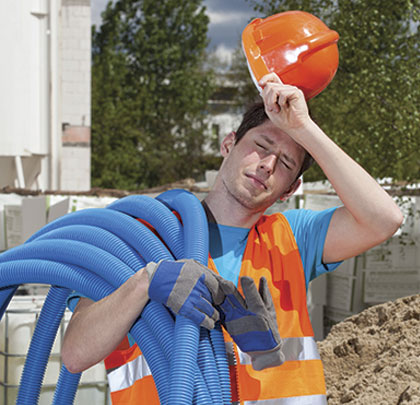The approach of summer is a reminder to us all of the need to recognize, and act to prevent, the harmful effects of excessive heat. Workers are particularly vulnerable to the health impacts of heat exposure. Workers may experience longer or more intense heat exposures and are more likely to engage in strenuous physical activity in the heat than the general public. Also, in many cases workers rely on their employers to provide opportunities for limiting their time in the heat, ensuring adequate rest breaks, and promoting hydration.
The recently published NIOSH Criteria for a Recommended Standard: Occupational Exposure to Heat and Hot Environments, contains a lot of information related to how heat stress affects the body, individual and environmental risk factors, heat-related illnesses, and recommendations to protect workers. Some of these recommendations have been summarized below.
NOTE: Read the NIOSH Criteria Occupational Exposure to Heat and Hot Environments at www.cdc.gov/niosh/docs/2016-106/pdfs/2016-106.pdf for detailed information and recommended alert and exposure limits.
NIOSH RECOMMENDED LIMITS
NIOSH has recommended alert limits (RALs) for unacclimatized workers and recommended exposure limits (RELs) for acclimatized workers. Acclimatization is the result of beneficial physiological adaptations (e.g., increased sweating efficiency) that occur after gradual increased exposure to a hot environment. The total heat exposure for all workers should be controlled so that unprotected healthy workers are not exposed to heat greater than the appropriate RAL or REL.
MEDICAL MONITORING PROGRAM
A medical monitoring program should be established for all workers who are or may be exposed to heat stress above the RAL, whether they are acclimatized or not. This program is intended to prevent adverse outcomes and to identify early signs or symptoms associated with heat-related illness. Employers should provide medical evaluations and procedures performed by or under the direction of the responsible healthcare provider at no cost to workers, including preplacement and periodic medical evaluations, as well as a plan for monitoring workers.
TRAINING
All workers and supervisors who work in environments where there is potential risk of heat injury or illness should participate in training programs. Training should include information about heat stress, risk factors, signs and symptoms, and first aid. Proper precautions (e.g., hydration, rest breaks, acclimatization, etc.) for work in hot areas should be explained. Workers should also be trained on the effects of therapeutic drugs, over-the-counter medications, alcohol, and caffeine, which may reduce heat tolerance and increase the risk of illness. Proper care and use of heat-protective clothing and equipment should be explained and demonstrated. In addition, supervisors should be trained on monitoring weather reports and responding to hot weather advisories.
CONTROL OF HEAT STRESS
Heat stress can be reduced by implementing engineering and work practice controls. Engineering controls might include those that aim to increase air velocity; reflective or heat-absorbing shielding or barriers; and reduction of steam leaks, wet floors, or humidity. Work practice recommendations include the following:
- Limit time in the heat, increase recovery time spent in a cool environment, or both.
Reduce the metabolic demands of the job (e.g., use tools with efficient ergonomic designs or specifically intended to minimize manual strain, or increase the number of workers per task). - Train supervisors and workers to recognize early signs and symptoms of heat-related illnesses and to administer first aid.
- Implement a buddy system where workers observe each other for early signs and symptoms of heat intolerance.
- Some situations may require workers to conduct self-monitoring; a work group (i.e., workers, a qualified healthcare provider, and a safety manager) should be developed to make decisions on self-monitoring options and standard operating procedures.
- Provide adequate amounts of cool, potable water near the work area and encourage workers to drink. If in the heat <2 hours and involved in moderate work activities, drink 1 cup (8 oz) of water every 15–20 minutes. During prolonged sweating lasting several hours, drink sports drinks containing balanced electrolytes. Avoid alcohol and drinks with high caffeine or sugar. Generally, fluid intake should not exceed 6 cups per hour.
- Implement a heat alert program whenever the weather service forecasts that a heat wave is likely to occur in the following days.
- Institute a heat acclimatization plan and increase physical fitness. Gradually increase time in hot conditions over 7 to 14 days.
° For new workers: The schedule should be no more than 20 percent of the usual duration of work in the heat on day 1 and no more than 20 percent increase on each additional day.
° For workers with previous experience: The schedule should be no more than 50 percent of the usual duration of work in the heat on day 1, 60 percent on day 2, 80 percent on day 3, and 100 percent on day 4. Closely supervise new employees for the first 14 days or until they are fully acclimatized.
PPE AND CLOTHING
If the total heat stress exceeds the RAL or REL, despite the use of engineering and work practice controls, the employer should provide workers with protective equipment and clothing (e.g., water-cooled garments, air-cooled garments, ice-packet vests, wetted over-garments, and heat-reflective aprons or suits). ■
About the Author: Ms. Jacklitsch is a health scientist with the NIOSH Education and Information Division and Dr. Watson is an epidemiologist in the NIOSH Western States Division. For more information on heat stress, visit www.cdc.gov/niosh/topics/heatstress.
_________________________________________________________________________
Modern Contractor Solutions – June 2016
Did you enjoy this article?
Subscribe to the FREE Digital Edition of Modern Contractor Solutions magazine.



